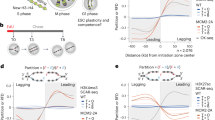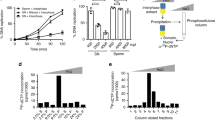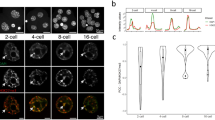Abstract
Parental histones, the carriers of posttranslational modifications, are deposited evenly onto the replicating DNA of sister chromatids in a process dependent on the Mcm2 subunit of DNA helicase and the Pole3 subunit of leading-strand DNA polymerase. The biological significance of parental histone propagation remains unclear. Here we show that Mcm2-mutated or Pole3-deleted mouse embryonic stem cells (ESCs) display aberrant histone landscapes and impaired neural differentiation. Mutation of the Mcm2 histone-binding domain causes defects in pre-implantation development and embryonic lethality. ESCs with biased parental histone transfer exhibit increased epigenetic heterogeneity, showing altered histone variant H3.3 and H3K27me3 patterning at genomic sites regulating differentiation genes. Our results indicate that the lagging strand pattern of H3.3 leads to the redistribution of H3K27me3 in Mcm2-2A ESCs. We demonstrate that symmetric parental histone deposition to sister chromatids contributes to cellular differentiation and development.
This is a preview of subscription content, access via your institution
Access options
Access Nature and 54 other Nature Portfolio journals
Get Nature+, our best-value online-access subscription
$29.99 / 30 days
cancel any time
Subscribe to this journal
Receive 12 print issues and online access
$209.00 per year
only $17.42 per issue
Buy this article
- Purchase on Springer Link
- Instant access to full article PDF
Prices may be subject to local taxes which are calculated during checkout







Similar content being viewed by others
Data availability
The datasets generated during and/or analyzed during the current study are available in the Expression Omnibus data base repository (GEO). The next-generation sequencing datasets (RNA-seq, scRNA-seq, CUT&Tag, scCUT&Tag, eSPAN, CUT&RUN, MINCE-seq, ATAC-seq and Repli-ATAC-seq) have been deposited in the GEO with accession GSE185271 (https://www.ncbi.nlm.nih.gov/geo/query/acc.cgi?&acc=GSE185271). Publication ChIP-seq datasets used for comparison were downloaded from GEO (https://www.ncbi.nlm.nih.gov/geo/) under accession numbers GSM3267572 (H3.3, https://www.ncbi.nlm.nih.gov/geo/query/acc.cgi?acc=GSM3267572), GSM2345017 (H3.3, https://www.ncbi.nlm.nih.gov/geo/query/acc.cgi?acc=GSM2345017), GSM1555116 (H3.3, https://www.ncbi.nlm.nih.gov/geo/query/acc.cgi?acc=GSM1555116), GSM1207789 (Hira, https://www.ncbi.nlm.nih.gov/geo/query/acc.cgi?acc=GSM1207789), GSM4774514 (Ezh2, https://www.ncbi.nlm.nih.gov/geo/query/acc.cgi?acc=GSM4774514), GSM4774522 (Jarid2, https://www.ncbi.nlm.nih.gov/geo/query/acc.cgi?acc=GSM4774522), GSM3483858 (Suz12, https://www.ncbi.nlm.nih.gov/geo/query/acc.cgi?acc=GSM3483858), GSM3483878 (H2AK119ub1, https://www.ncbi.nlm.nih.gov/geo/query/acc.cgi?acc=GSM3483878) and GSM3483853 (Ring1B, https://www.ncbi.nlm.nih.gov/geo/query/acc.cgi?acc=GSM3483853). Several ESC marker TF peak location files according published ChIP-seq data were downloaded from ENCODE (https://www.encodeproject.org/) under accession number ENCSR392DGA (Pou5f1 of ESCs, https://www.encodeproject.org/experiments/ENCSR392DGA/). The published E14TG2a datasets were downloaded from GEO under accession number GSE66582 (https://www.ncbi.nlm.nih.gov/geo/query/acc.cgi?acc=GSE66582). Primers for genotyping and qPCR can be found in Supplementary Table 1. Summary of mouse genotypes can be found in Supplementary Tables 2–7. The gRNA and donor sequences for the CRISPR–Cas9 can be found in Supplementary Table 8. The antibody information used for CUT&Tag, scCUT&Tag, eSPAN, CUT&RUN, immunofluorescence, fluorescent activated cell sorting and western blot can be found in Supplementary Table 9.
Code availability
We have made use of publicly available software, tools and code. The public pipeline used to calculate bias via eSPAN analysis is available with the following link: https://github.com/clouds-drift/eSPAN-bias. The published scripts used to call lineage barcodes are available with the following link: https://github.com/AllonKleinLab/LARRY. All other codes used to generate the analysis in this study have been placed in Zenodo through the following link: https://doi.org/10.5281/zenodo.7866527.
References
Stillman, B. Histone modifications: insights into their influence on gene expression. Cell 175, 6–9 (2018).
Bannister, A. J. & Kouzarides, T. Regulation of chromatin by histone modifications. Cell Res. 21, 381–395 (2011).
Scharf, A. N. et al. Monomethylation of lysine 20 on histone H4 facilitates chromatin maturation. Mol. Cell. Biol. 29, 57–67 (2009).
Alabert, C. et al. Two distinct modes for propagation of histone PTMs across the cell cycle. Genes Dev. 29, 585–590 (2015).
Xu, M., Wang, W., Chen, S. & Zhu, B. A model for mitotic inheritance of histone lysine methylation. EMBO Rep. 13, 60–67 (2011).
Stewart-Morgan, K. R., Petryk, N. & Groth, A. Chromatin replication and epigenetic cell memory. Nat. Cell Biol. 22, 361–371 (2020).
Gan, H. et al. The Mcm2-Ctf4-Polalpha axis facilitates parental histone H3-H4 transfer to lagging strands. Mol. Cell 72, 140–151.e3 (2018).
Petryk, N. et al. MCM2 promotes symmetric inheritance of modified histones during DNA replication. Science 361, 1389–1392 (2018).
Yu, C. et al. A mechanism for preventing asymmetric histone segregation onto replicating DNA strands. Science 361, 1386–1389 (2018).
Reverón-Gómez, N. et al. Accurate recycling of parental histones reproduces the histone modification landscape during DNA replication. Mol. Cell 72, 239–249.e5 (2018).
Escobar, T. M. et al. Active and repressed chromatin domains exhibit distinct nucleosome segregation during DNA replication. Cell 179, 953–963.e11 (2019).
Schlissel, G. & Rine, J. The nucleosome core particle remembers its position through DNA replication and RNA transcription. Proc. Natl Acad. Sci. USA 116, 20605–20611 (2019).
Reinberg, D. & Vales, L. D. Chromatin domains rich in inheritance. Science 361, 33–34 (2018).
Li, Z. et al. DNA polymerase alpha interacts with H3-H4 and facilitates the transfer of parental histones to lagging strands. Sci. Adv. 6, eabb5820 (2020).
Kaya-Okur, H. S. et al. CUT&Tag for efficient epigenomic profiling of small samples and single cells. Nat. Commun. 10, 1930 (2019).
Schuettengruber, B., Bourbon, H.-M., Di Croce, L. & Cavalli, G. Genome regulation by polycomb and trithorax: 70 years and counting. Cell 171, 34–57 (2017).
Morgan, M. A. J. & Shilatifard, A. Reevaluating the roles of histone-modifying enzymes and their associated chromatin modifications in transcriptional regulation. Nat. Genet. 52, 1271–1281 (2020).
Yu, C. et al. Strand-specific analysis shows protein binding at replication forks and PCNA unloading from lagging strands when forks stall. Mol. Cell 56, 551–563 (2014).
Li, S., Prasanna, X., Salo, V. T., Vattulainen, I. & Ikonen, E. An efficient auxin-inducible degron system with low basal degradation in human cells. Nat. Methods 16, 866–869 (2019).
Ming, X. et al. Kinetics and mechanisms of mitotic inheritance of DNA methylation and their roles in aging-associated methylome deterioration. Cell Res. 30, 980–996 (2020).
Weinreb, C., Rodriguez-Fraticelli, A., Camargo, F. D. & Klein, A. M. Lineage tracing on transcriptional landscapes links state to fate during differentiation. Science 367, eaaw3381 (2020).
Bartosovic, M., Kabbe, M. & Castelo-Branco, G. Single-cell CUT&Tag profiles histone modifications and transcription factors in complex tissues. Nat. Biotechnol. 39, 825–835 (2021).
Wu, S. J. et al. Single-cell CUT&Tag analysis of chromatin modifications in differentiation and tumor progression. Nat. Biotechnol. 39, 819–824 (2021).
Afsari, B., Geman, D. & Fertig, E. J. Learning dysregulated pathways in cancers from differential variability analysis. Cancer Inform. 13, 61–67 (2014).
Ramachandran, S. & Henikoff, S. Transcriptional regulators compete with nucleosomes post-replication. Cell 165, 580–592 (2016).
Stewart-Morgan, K. R., Reveron-Gomez, N. & Groth, A. Transcription restart establishes chromatin accessibility after DNA replication. Mol. Cell 75, 284–297.e6 (2019).
Banaszynski, L. A. et al. Hira-dependent histone H3.3 deposition facilitates PRC2 recruitment at developmental loci in ES cells. Cell 155, 107–120 (2013).
Zhang, H. et al. RPA interacts with HIRA and regulates H3.3 deposition at gene regulatory elements in mammalian cells. Mol. Cell 65, 272–284 (2017).
Goldberg, A. D. et al. Distinct factors control histone variant H3.3 localization at specific genomic regions. Cell 140, 678–691 (2010).
Xu, X. et al. Stable inheritance of H3.3-containing nucleosomes during mitotic cell divisions. Nat. Commun. 13, 2514 (2022).
Hojfeldt, J. W. et al. Accurate H3K27 methylation can be established de novo by SUZ12-directed PRC2. Nat. Struct. Mol. Biol. 25, 225–232 (2018).
Xie, J. et al. Histone H3 threonine phosphorylation regulates asymmetric histone inheritance in the Drosophila male germline. Cell 163, 920–933 (2015).
Wooten, M. et al. Asymmetric histone inheritance via strand-specific incorporation and biased replication fork movement. Nat. Struct. Mol. Biol. 26, 732–743 (2019).
Tran, V., Lim, C., Xie, J. & Chen, X. Asymmetric division of Drosophila male germline stem cell shows asymmetric histone distribution. Science 338, 679–682 (2012).
Saxton, D. S. & Rine, J. Epigenetic memory independent of symmetric histone inheritance. eLife 8, e51421 (2019).
Xu, X., Hua, X., Brown, K., Ren, X. & Zhang, Z. Mcm2 promotes stem cell differentiation via its ability to bind H3-H4. eLife 11, e80917 (2022).
Atlasi, Y. & Stunnenberg, H. G. The interplay of epigenetic marks during stem cell differentiation and development. Nat. Rev. Genet. 18, 643–658 (2017).
Wu, J. et al. Stem cells and interspecies chimaeras. Nature 540, 51–59 (2016).
Ran, F. A. et al. Genome engineering using the CRISPR–Cas9 system. Nat. Protoc. 8, 2281–2308 (2013).
Conti, L. et al. Niche-independent symmetrical self-renewal of a mammalian tissue stem cell. PLoS Biol. 3, e283 (2005).
Carter, B. et al. Mapping histone modifications in low cell number and single cells using antibody-guided chromatin tagmentation (ACT-seq). Nat. Commun. 10, 3747 (2019).
Li, Z., Hua, X., Serra-Cardona, A., Xu, X. & Zhang, Z. Efficient and strand-specific profiling of replicating chromatin with enrichment and sequencing of protein-associated nascent DNA in mammalian cells. Nat. Protoc. 16, 2698–2721 (2021).
Acknowledgements
We thank Q. Li (Center for Energy Metabolism and Reproduction, Shenzhen Institute of Advanced Technology, Chinese Academy of Sciences) for his suggestions and help with embryonic staining, and K. Harper of Harper Health & Science Communications, LLC, for editorial assistance. This work was supported by the following funding: National Key R&D Program of China (grant no. 2019YFA0903800 to H.G.), the Major Program of the National Natural Science Foundation of China (32090031 to H.G.), the Strategic Priority Research Program of the Chinese Academy of Sciences (XDB0480000 to H.G.), the General Program of the National Natural Science Foundation of China (32070610 to H.G.), the National Natural Science Foundation of China for Young Scholars (32000580 to Q.W., 32001043 to Y.S., 32100460 to J.Z. and 32101178 to Y.Y.), the Guangdong Province Fund for Distinguished Young Scholars (2021B1515020109 to H.G.), Guangdong Basic and Applied Basic Research Foundation (2021A1515110377 to X.K.), Shenzhen Institute of Synthetic Biology Scientific Research Program (JCHZ20200005, ZTXM20190019 to H.G.) and National Institutes of Health Grant (R01GM130588 to C.Y.).
Author information
Authors and Affiliations
Contributions
H.G. supervised the research. H.G. and Q.W. conceived and designed the experiments. Q.W., C.T., G.S., Y.S., C.M., S.Y., Xiaoyan Liang and X. Lei performed the experiments. H.G., Q.W., J.Z., C.T., X. Li, G.S., C.M., S.Y., Xiaoyan Liang and X. Lei performed statistical analysis. H.G., Q.W., J.Z., C.T., X.L., G.S., Y.G., C.M., S.Y., Xiaoyan Liang, X. Lei., Z.L. and Z.W. analyzed the data. H.G., Q.W., J.Z., Y.S., X.K., N.W., Y.Y., H.W., Xiaohuan Liang, J.T., S.M.O., X. Lei, X. Liu and Z.L. contributed materials. H.G., Q.W., Y.G., S.M.O., C.Y., X. Liu, Z.L. and Z.W. wrote the paper.
Corresponding author
Ethics declarations
Competing interests
The authors declare no competing interests.
Peer review
Peer review information
Nature Genetics thanks the anonymous reviewers for their contribution to the peer review of this work. Peer reviewer reports are available.
Additional information
Publisher’s note Springer Nature remains neutral with regard to jurisdictional claims in published maps and institutional affiliations.
Supplementary information
Supplementary Information
Supplementary Figs. 1–28 (unprocessed immunoblots), Tables 1–9, Notes 1–11 and references.
Supplementary Data
Exact P values of Supplementary Figs. 2d (H3K27me3, H3K4me3 and H3K9me3); 6a,b; 12a–e,i and 23a.
Rights and permissions
Springer Nature or its licensor (e.g. a society or other partner) holds exclusive rights to this article under a publishing agreement with the author(s) or other rightsholder(s); author self-archiving of the accepted manuscript version of this article is solely governed by the terms of such publishing agreement and applicable law.
About this article
Cite this article
Wen, Q., Zhou, J., Tian, C. et al. Symmetric inheritance of parental histones contributes to safeguarding the fate of mouse embryonic stem cells during differentiation. Nat Genet 55, 1555–1566 (2023). https://doi.org/10.1038/s41588-023-01477-w
Received:
Accepted:
Published:
Issue Date:
DOI: https://doi.org/10.1038/s41588-023-01477-w
This article is cited by
-
The functions of SET domain bifurcated histone lysine methyltransferase 1 (SETDB1) in biological process and disease
Epigenetics & Chromatin (2023)
-
A fork in the road to differentiation
Nature Genetics (2023)



